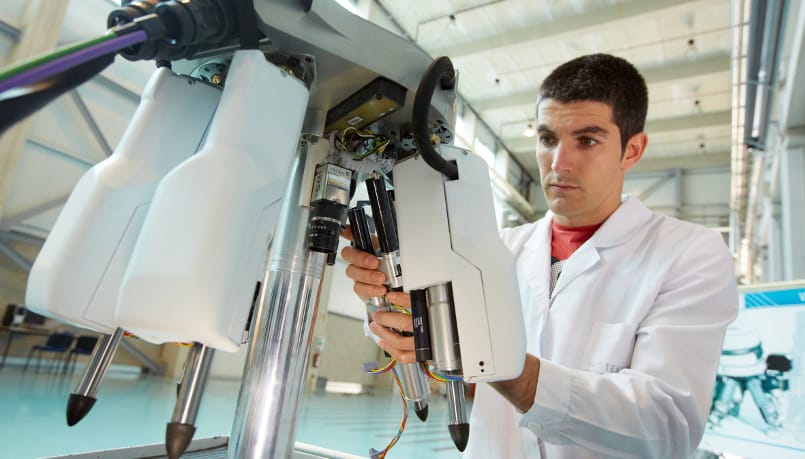Mikel Armendia (1983, Elgoibar, Spain) is the coordinator of the Twin-Control project. Having a master’s in Mechanical Engineering at the University of Mondragon (2007) and a PhD in Mechanical Engineering at the University of Mondragon (2011), he is currently a researcher at the Automation and Control Unit of the research centre IK4-Tekniker.
How did you come up with the idea of Twin-Control?
The concept of Twin-Control came up from the need to improve the performance of current simulation packages for machine tool and machining process performance analysis. This will be achieved by the combination of the different features that affect these processes and the integration with the real world. This combination of Cyber and Physical Worlds (Cyber Physical System, CPS) was previously presented by Jay Lee (University of Cincinnati) for the analysis of Wind-turbines for maintenance purposes.
What motivated you to undertake this project?
IK4-Tekniker has a big experience in the development of simulation models to analyse phenomena of different nature (mechanical, thermal, chemical…). Due to the importance of machine tool industry in the area to which IK4-TEKNIKER belongs, modelling and simulation of machine tools and machining process is of special interest. So what encouraged us to embark on the project was the challenge to improve the machine tool and machining process performance simulation by collaborating with some of the most capable European entities in the field of manufacturing.
How was the consortium formed?
SAMTECH and TEKNIKER came up with the idea of developing a more advanced simulation tool to analyse machine tool performance, by including the process, which is one of the main research fields of the University of Sheffield. This partner brought ModuleWorks to the consortium, which will undertake the tool-path simulation tasks that are needed for process models and will provide visualization capabilities.
Then, the University of Darmstadt joined to cover the energy efficiency field. For the monitoring and data management side, ARTIS and PREDICT were contacted by TEKNIKER due to a successful collaboration on the PowerOM project. For the end users, COMAU was proposed by SAMTECH, thanks to a previous collaboration in the MECOMAT project, and they came together with RENAULT, since it is one of their best customers. The aerospace tandem (GEPRO and MASA) was contacted by TEKNIKER to complete the consortium.
How will the Project be carried out during these 36 months?
In this first 6 months, the effort has been focused on the preliminary definition of the Twin-Control concept, which will be used as a reference to all the technical developments (Simulation and Monitoring fields) to be done in the following 18 months. In the last year of the project, all the developments will be implemented in the industrial use cases for validation.
What have been the achievements so far?
At this point, Twin-Control architecture has been defined, both for the simulation and monitoring sides. The role of each partner within Twin-Control has been clarified.
In addition, the industrial demonstration scenarios have been defined for the two use cases: aerospace and automotive. The machines and processes in which Twin-Control will be validated have been defined, together with a planning for the installation of monitoring hardware.
What long-term results do you expect?
The plan is that by the end of project Twin-Control software will be successfully developed, which will work in two operation modes: Simulation, for machine tool and machining process design, and Monitoring, for real process characterisation and control.
Besides, each of the partners will upgrade the modules that will integrate Twin-Control with additional features.
How do you expect that Twin-Control will change current manufacturing processes?
Twin-Control will allow defining more optimized processes that will lead to great set-up cost reductions and also provide more flexibility to the production lines. Furthermore, Twin-Control will provide more intelligence to the machine thanks to the enhanced monitoring capabilities that will bring the possibility of optimizing machining processes and assessing machine tool condition.
How do you see the future of machine tool industry?
I think that the trends are towards more intelligent machines that will be able to work autonomously, be capable for self-diagnosis and have more convenient communication with the operators (HMI). I would also say that the machine tool industry will be more flexible, it will be possible to change manufacturing processes using the same machine with the minimum set-up times. And these are precisely the two objectives with which Twin-Control is aligned.

